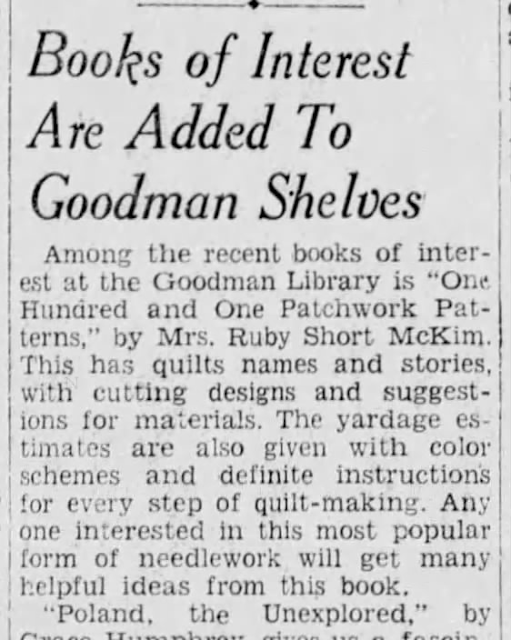In 1931, Ruby Short McKim published her a book. It featured not 5 quilt patterns, or 25 quilt patterns but a 101 quilt patterns! It was a groundbreaking book:
Most of us know the book. For many of us, it was our first introduction to quiltmaking. The book featured templates and instructions for patterns.
A smorgasbord of patterns in the book insured that there was a pattern for every quilter. Many were older patterns like the Fish pattern originally published in 1900 in a book by Clara Stone:
McKim referred to the above pattern as Indian Hatchet although the more common name we know of is Lattice.
I do believe that my Cherry Basket quilt used this pattern. Not only do the templates match but the quilt is done in the brown and red colors that McKim suggested. This was also offered in one of McKim's catalogs as a die cut kit and is possibly an example.
All this was wonderful for quilt inspiration at the time...except that the year was 1931 and the Depression gripped the country.
The book was marketed for the price of $1.50. However, when we consider that the price of a loaf of bread that year was $.08, it seems possible that a $1.50 could probably feed a family of 4 for a week.
I can also imagine some husbands saying to their wives, "When are you ever going to make 101 quilts?"
Quilting was viewed favorably as a way to use up scraps and be frugal. Despite the price of the book and the economic state of the country, there was one saving grace for women who wanted to make quilts: librarians.
It seems like in every state, libraries purchased the book for their collection. Back in 1931, the library would submit an article to the local newspaper and indicate what new books were available. Sometimes there was just a brief list in the newspaper:
Bristol, Vermont
But more often, the library would elaborate on the value and popularity of the book.
Parsons, Kansas
Kittanning, Pennsylvania
The idea of tracing the patterns was critical. Women could check out the book and trace the patterns of the quilts they liked. I know they did this. I have a wooden box of ephemera of drawings and diagrams that women made during the 20th century. Often the patterns are on tissue paper that was used to package things like shirts or other kinds of clothing.
In essence the librarians marketed the book for McKim and insured her name was one synonymous with quilting. And once The Depression passed, women did buy the book...even today.



.JPG)










when i inherited a box of fabric from my husband's grandmother, there was an original mckim leaflet of patterns in the box...it is a book that has endured...and of course i have one and have used it often!
ReplyDeleteWhat an excellent post about the famous McKim book. I actually have a copy of it too bought at a thrift store when I first arrived here. But I had no idea of its significance in the quilt history world. How wonderful to have such connections in our quilting world, Michele.
ReplyDeleteI got behind in blog-reading -- love this post. Thanks for the great history!
ReplyDelete